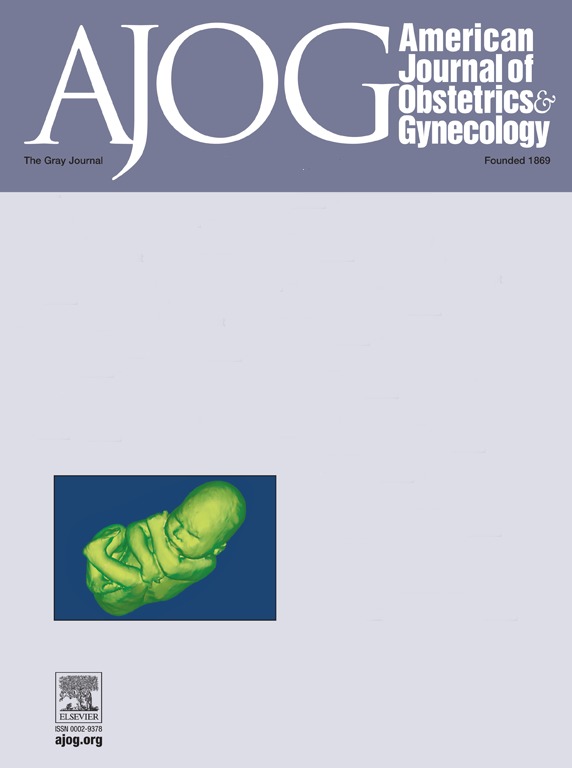Impact of Social Determinants of Health on Fecal Incontinence Treatment In Older Women.
IF 8.7
1区 医学
Q1 OBSTETRICS & GYNECOLOGY
引用次数: 0
Abstract
OBJECTIVE Many women with fecal incontinence (FI) do not seek care despite the availability of effective treatments. Factors influencing care-seeking for FI are not well elucidated, and the role of social determinants of health (SDOHs) in FI treatment utilization is unknown. Our primary aim was to determine the association between SDOHs and treatment utilization among Medicare beneficiaries with FI. We secondarily aimed to determine the baseline treatment utilization rate and to determine factors associated with FI treatment utilization. STUDY DESIGN We conducted a retrospective cohort study of Medicare beneficiaries with FI based on 2010-2018 claims data from a 5% national sample. Women with FI were identified by diagnosis codes, and those receiving treatment were identified by Current Procedural Terminology codes for pelvic floor physical therapy with biofeedback, sacral neuromodulation, anal sphincteroplasty, percutaneous tibial nerve stimulation, and anal procedures. Comorbidity was assessed via the Charlson comorbidity index. SDOHs were defined by the Social Vulnerability Index (SVI), a census-based score accounting for factors such as socioeconomic status, disability, ethnicity, language, housing type, and transportation by county. SVI is reported as a percentile rank, with higher percentiles reflecting greater vulnerability. Additional SDOH variables analyzed included Medicaid dual eligibility status, per capita income, and proportion of the population below poverty level. The association between SDOHs and treatment for FI was evaluated using Cox proportional hazards models. RESULTS We identified 33,010 women with a diagnosis of FI, of whom 3,160 (9.6%) underwent treatment. Treatment modalities included anal procedures (6.5%), sacral neuromodulation (2.4%), percutaneous tibial nerve stimulation (0.9%), anal sphincteroplasty (0.4%), and pelvic floor physical therapy with biofeedback (0.1%). Those who did not undergo treatment were older, more commonly Medicaid dual eligible, had lower per capita incomes, higher poverty rates, and higher Charlson comorbidity index scores (all p<0.01, Table 1). Higher SVI scores (HR 0.88, 95% CI 0.79-0.97), Medicaid dual eligibility (HR 0.45, 95% CI 0.39-0.52), and residence in high poverty counties (HR 0.82, 95% CI 0.74-0.9) were associated with lower likelihood of treatment, whereas higher income was associated with greater likelihood of treatment (HR 1.44, 95% CI 1.3-1.59). The association between treatment and Medicaid dual eligibility (HR 0.91, 95% CI 0.82-1.01), income (HR 1.41, 95% CI 1.27-1.56), and poverty rate (HR 0.86, 95% CI 0.78-0.95) persisted after accounting for patient characteristics; the association between SVI and treatment did not. Increasing age (HR 0.96, 95% CI 0.96-0.97), Black race (HR 0.82, 95% CI 0.7-0.97), higher Charlson comorbidity index (HR 0.65, 95% CI 0.06-0.70), depression (HR 0.66, 95% CI 0.53-0.81), immobility (HR 0.36, 95% CI 0.22-0.61), and loose stools (HR 0.87, 95% CI 0.79-0.94) were associated with lower treatment receipt, whereas urinary incontinence (HR 1.71, 95% CI 1.57-1.85) and constipation (HR 1.29, 95% CI 1.19-1.40) were associated with higher likelihood of treatment. CONCLUSIONS Treatment utilization among women with FI is low even within an insured population. In addition to comorbid conditions, social factors reflecting social disadvantage are associated with lower treatment utilization. Future efforts to increase treatment utilization should target this vulnerable group of women.健康的社会决定因素对老年妇女大便失禁治疗的影响
目的:尽管有有效的治疗方法,许多女性尿失禁(FI)不寻求护理。影响FI求医的因素尚不清楚,健康社会决定因素(SDOHs)在FI治疗利用中的作用尚不清楚。我们的主要目的是确定患有FI的医疗保险受益人中sdoh与治疗利用之间的关系。我们的次要目的是确定基线治疗利用率,并确定与FI治疗利用率相关的因素。研究设计:我们对患有FI的医疗保险受益人进行了一项回顾性队列研究,该研究基于2010-2018年来自5%国家样本的索赔数据。FI女性通过诊断代码识别,接受治疗的女性通过现行程序术语代码识别盆底物理治疗,包括生物反馈、骶骨神经调节、肛门括约肌成形术、经皮胫神经刺激和肛门手术。通过Charlson合并症指数评估合并症。SDOHs由社会脆弱性指数(SVI)定义,SVI是一个基于人口普查的分数,考虑了社会经济地位、残疾、种族、语言、住房类型和交通等因素。SVI被报告为一个百分位数排名,更高的百分位数反映出更大的脆弱性。分析的其他SDOH变量包括医疗补助双重资格状态、人均收入和低于贫困水平的人口比例。使用Cox比例风险模型评估SDOHs与FI治疗之间的关系。结果:我们确定了33010名确诊为FI的女性,其中3160名(9.6%)接受了治疗。治疗方式包括肛门手术(6.5%)、骶骨神经调节(2.4%)、经皮胫神经刺激(0.9%)、肛门括约肌成形术(0.4%)和盆底生物反馈物理治疗(0.1%)。未接受治疗的患者年龄较大,更符合医疗补助双重资格,人均收入较低,贫困率较高,Charlson合并症指数评分较高(均p<0.01,表1)。较高的SVI评分(HR 0.88, 95% CI 0.79-0.97)、医疗补助双重资格(HR 0.45, 95% CI 0.39-0.52)和居住在高贫困县(HR 0.82, 95% CI 0.74-0.9)与较低的治疗可能性相关,而较高的收入与较高的治疗可能性相关(HR 1.44, 95% CI 1.3-1.59)。在考虑了患者特征后,治疗与医疗补助双重资格(HR 0.91, 95% CI 0.82-1.01)、收入(HR 1.41, 95% CI 1.27-1.56)和贫困率(HR 0.86, 95% CI 0.78-0.95)之间的关联仍然存在;SVI和治疗之间没有关联。年龄增加(HR 0.96, 95% CI 0.96-0.97)、黑人(HR 0.82, 95% CI 0.7-0.97)、较高的Charlson合病指数(HR 0.65, 95% CI 0.06-0.70)、抑郁(HR 0.66, 95% CI 0.53-0.81)、不动(HR 0.36, 95% CI 0.22-0.61)和稀便(HR 0.87, 95% CI 0.79-0.94)与较低的治疗率相关,而尿失禁(HR 1.71, 95% CI 1.57-1.85)和便秘(HR 1.29, 95% CI 1.19-1.40)与较高的治疗可能性相关。结论:即使在参保人群中,FI妇女的治疗利用率也很低。除了合并症外,反映社会劣势的社会因素也与较低的治疗利用率有关。今后提高治疗利用率的努力应以这一弱势妇女群体为目标。
本文章由计算机程序翻译,如有差异,请以英文原文为准。
求助全文
约1分钟内获得全文
求助全文
来源期刊
CiteScore
15.90
自引率
7.10%
发文量
2237
审稿时长
47 days
期刊介绍:
The American Journal of Obstetrics and Gynecology, known as "The Gray Journal," covers the entire spectrum of Obstetrics and Gynecology. It aims to publish original research (clinical and translational), reviews, opinions, video clips, podcasts, and interviews that contribute to understanding health and disease and have the potential to impact the practice of women's healthcare.
Focus Areas:
Diagnosis, Treatment, Prediction, and Prevention: The journal focuses on research related to the diagnosis, treatment, prediction, and prevention of obstetrical and gynecological disorders.
Biology of Reproduction: AJOG publishes work on the biology of reproduction, including studies on reproductive physiology and mechanisms of obstetrical and gynecological diseases.
Content Types:
Original Research: Clinical and translational research articles.
Reviews: Comprehensive reviews providing insights into various aspects of obstetrics and gynecology.
Opinions: Perspectives and opinions on important topics in the field.
Multimedia Content: Video clips, podcasts, and interviews.
Peer Review Process:
All submissions undergo a rigorous peer review process to ensure quality and relevance to the field of obstetrics and gynecology.

 求助内容:
求助内容: 应助结果提醒方式:
应助结果提醒方式:


